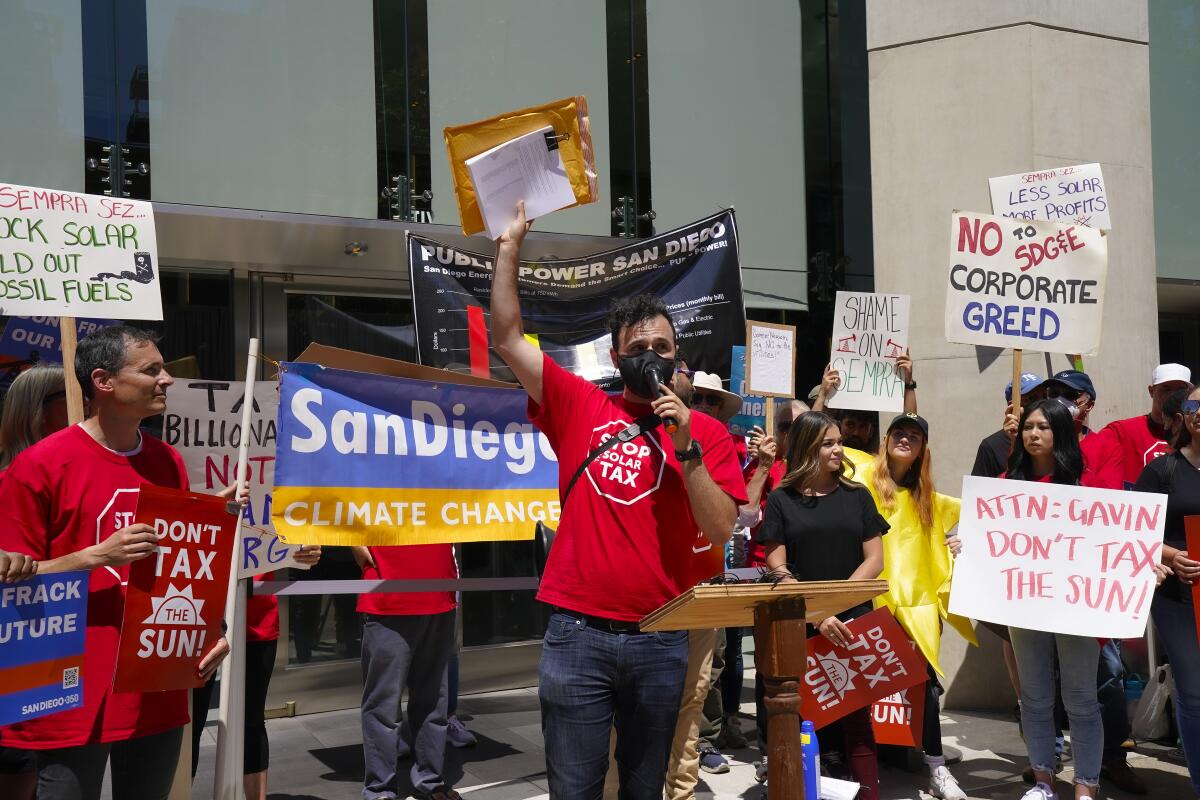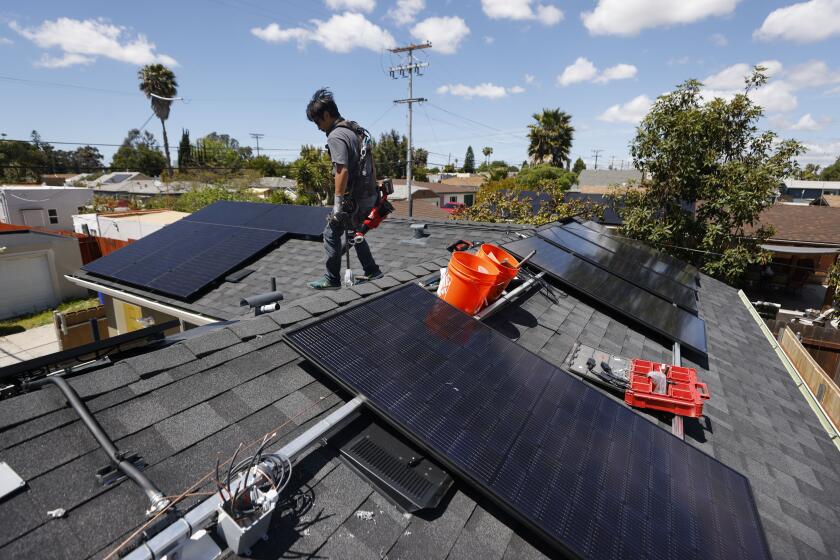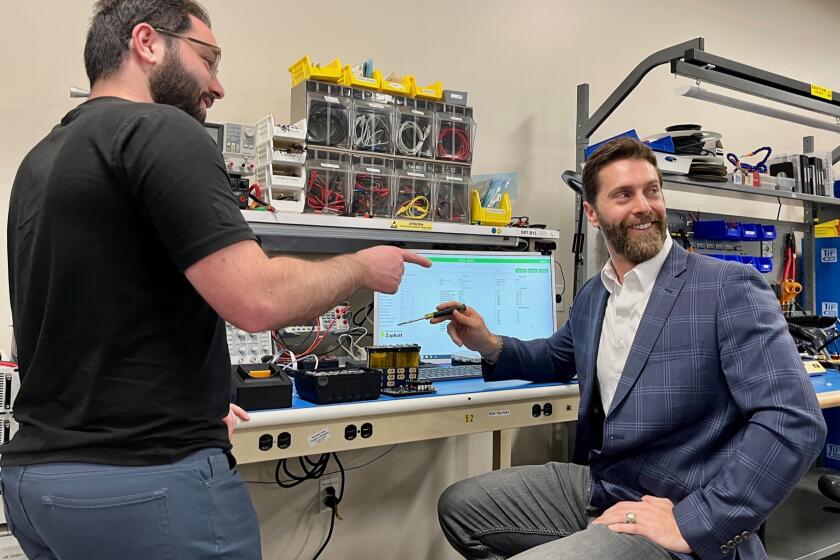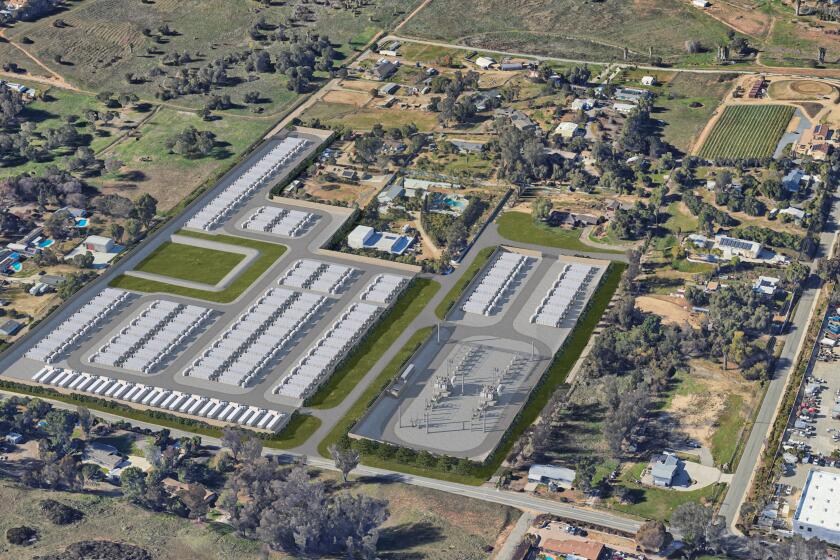Looming decision on new rooftop solar rules draws protesters in front of Sempra headquarters

Final decision by Public Utilities Commission has been on hold for months.
A proposed decision before California Public Utilities Commission that could dramatically change the financial rules for rooftop solar across the state drew about 75 protesters Tuesday in front of the headquarters of Sempra, the parent company of San Diego Gas & Electric.
“Because Sempra and SDG&E see rooftop solar as competition for them, they are trying to burn it to the ground,” Dave Rosenfeld, executive director of the Solar Rights Alliance, told the demonstrators, many wearing T-shirts and carrying signs that said “Don’t Tax The Sun.”
The demonstration is one of a series of protests the group has scheduled in the next 10 days at offices of investor-owned utilities, including Pacific Gas & Electric and Southern California Edison. With front doors of Sempra’s downtown building locked, organizers dropped off a “cease and desist” petition signed by 15,000 California residents that called on the state’s power companies to “reverse course on your attack campaign on rooftop solar.”

In an email to the Union-Tribune, an SDG&E spokesperson said the utility is “a strong supporter of solar” but “the current net energy metering structure, which was implemented when solar utilization was low, needs to be reformed to make it fair for all customers — especially those who rent their homes.”
Roughly 1.3 million Californians have installed rooftop solar on their homes and businesses. Under net energy metering, or NEM, when a rooftop system generates more energy than it actually consumes, the excess can be sent back to the electric grid and customers receive credits on their bills.
California’s NEM rules have not been changed since January 2016, and the commission has been working for years on an update, colloquially called NEM 3.0.
In December, a complicated 204-page proposed decision was released by the Public Utilities Commission, known as the CPUC for short. If passed, it would significantly alter existing solar regulations.
The revisions include creating a “grid participation charge” of $8 per kilowatt on the solar systems of residential customers. With typical rooftop installations being 5 to 6 kilowatts, that would come to about $40 to $48 per month.
Another potential change would alter how much solar customers are paid when they send excess power back to the grid. Instead of being credited at the retail rate of electricity, customers would get paid at the “actual avoided cost,” which is much lower.
The state’s solar industry, as well as some clean energy and environmental groups, immediately condemned the proposed decision, insisting it would knee-cap California solar growth. For example, they say that since solar installations can cost tens of thousands of dollars, adding a grid participation charge would extend the payback period to such an extent that potential customers would not make the investment.
Utilities have long complained about California’s NEM rules, saying the growing number of installations leaves customers who don’t have solar paying an unfair share of the fixed costs that come with maintaining the electric system — things like wires, substations and transformers.
This “cost-shift” leads to non-solar customers paying disproportionately more on their monthly bills.
The utility commission’s proposed decision came out last December but a final vote has been put on hold for months. California’s governor appoints the voting the members of the commission and shortly after the proposed decision was announced, Gov. Gavin Newsom told reporters, “We still have some work to do” on the proposal.
As Tuesday’s protest wrapped up, Matthew Vasilakis, co-director of policy for the local environmental group Climate Action Campaign, said the NEM 3.0 proposal should be scrapped. “Instead, we want (the utilities commission) to keep NEM as it is and build on it, provide more programs and incentives to help more California families, especially low-income families, achieve energy independence with solar.”
But the utilities are not alone in calling for changes. The Natural Resource Defense Council, energy academics such as Severin Borenstein at UC Berkeley and The Utility Reform Network and the Public Advocates Office consumer groups have said the cost-shift issue needs to be corrected.
“It is grossly misleading for the solar industry to call proposed reforms a penalty on rooftop solar customers,” said Kathy Fairbanks, spokeswoman for Affordable Clean Energy For All, a group headed by the state’s investor-owned utilities, “when in reality the goal of reform is simply to ensure that everyone who uses the electric grid pays their fair share toward its maintenance and upkeep.”
There’s no firm date when the CPUC may make a final ruling. Some speculate it may come in a matter of weeks, others think it will take a few more months.
As per CPUC rules, a proposed decision can be amended before going to the five commissioners for a vote. It’s also possible that an “alternate proposed decision” could be put forth that is significantly different from the original.
It takes a majority vote of the commissioners to adopt a new measure.
Get U-T Business in your inbox on Mondays
Get ready for your week with the week’s top business stories from San Diego and California, in your inbox Monday mornings.
You may occasionally receive promotional content from the San Diego Union-Tribune.











